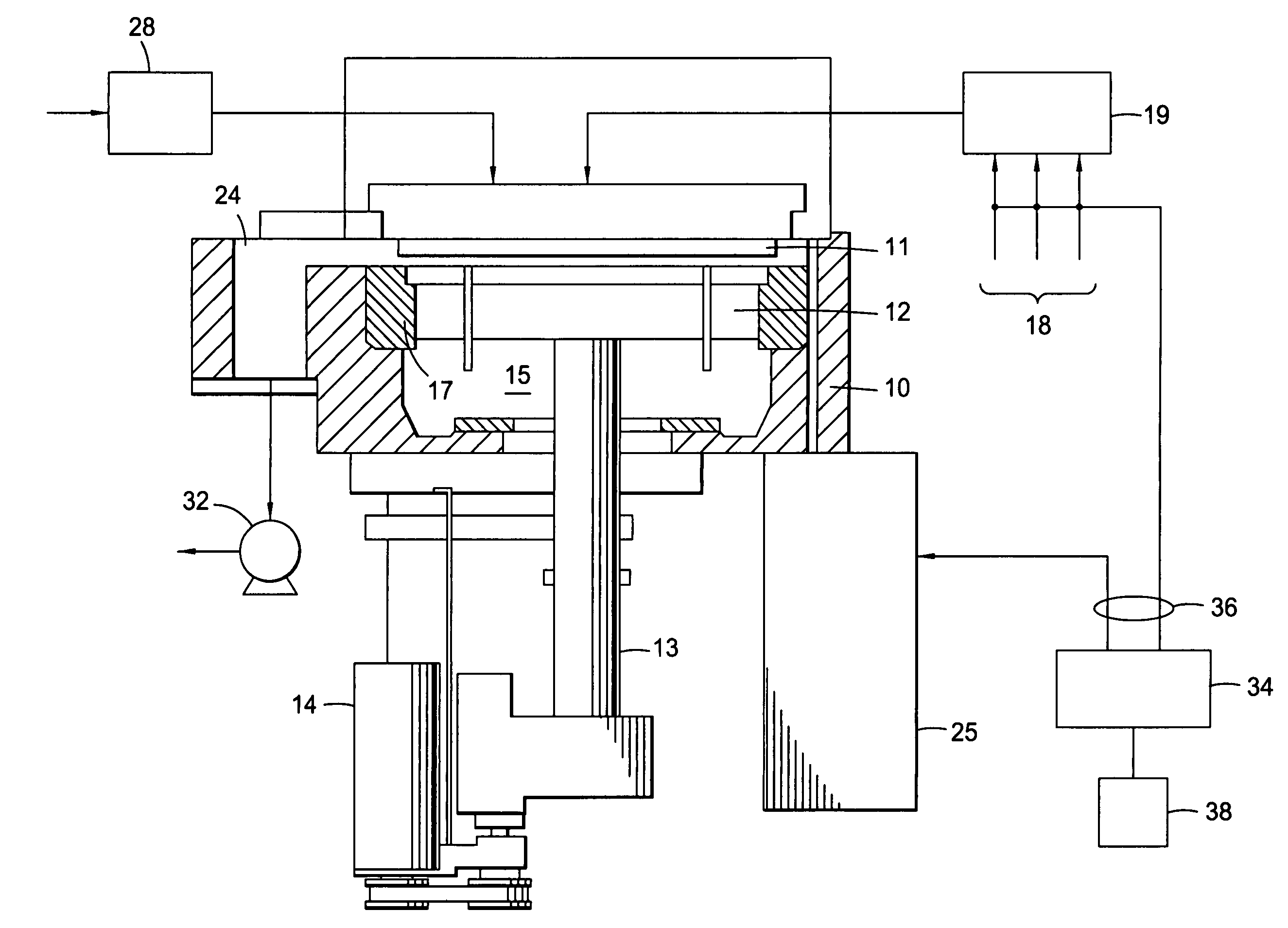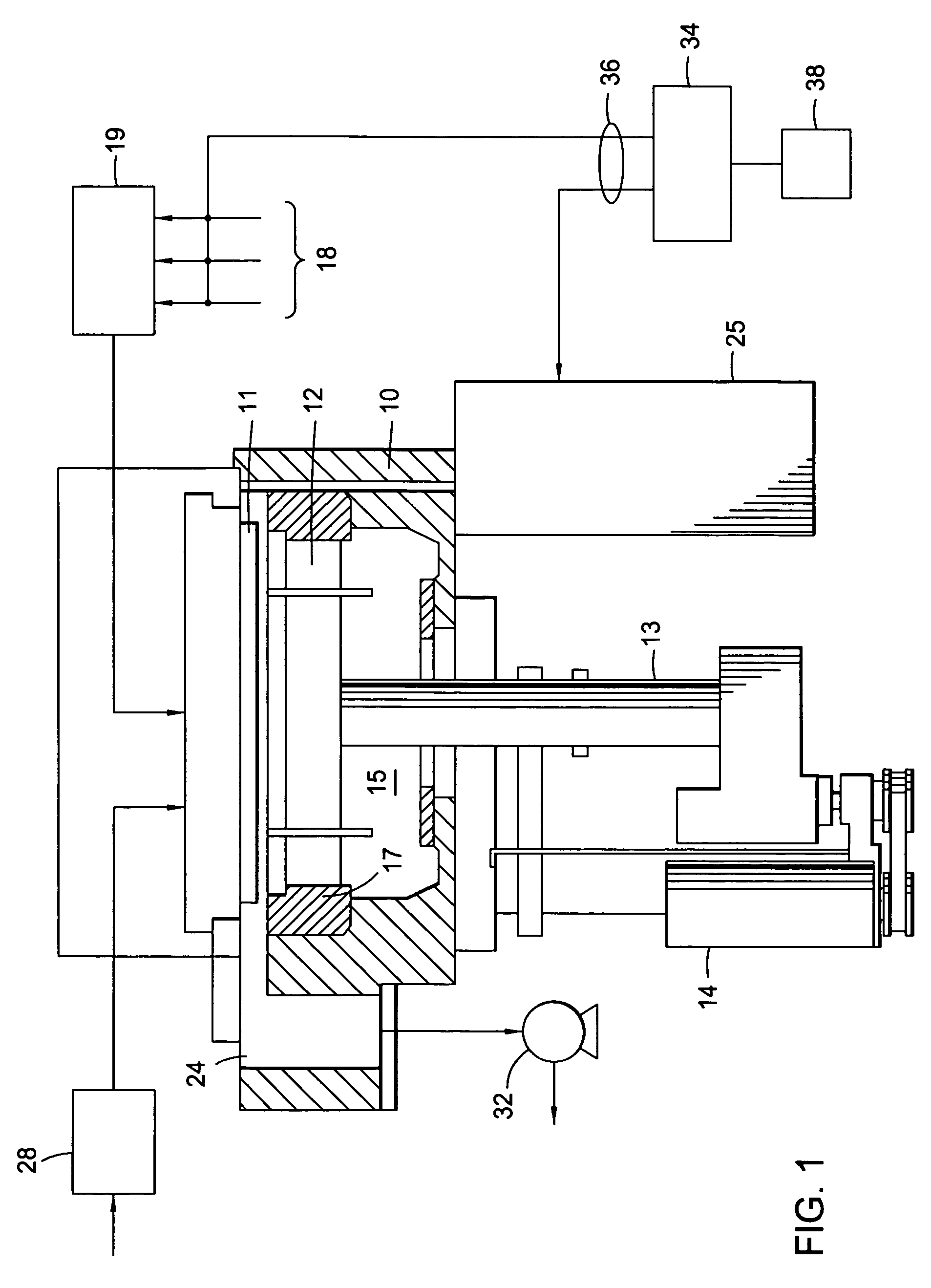Ultra low dielectric materials based on hybrid system of linear silicon precursor and organic porogen by plasma-enhanced chemical vapor deposition (PECVD)
a technology low dielectric material, which is applied in the direction of chemical vapor deposition coating, liquid surface applicator, coating, etc., can solve the problems of poor mechanical strength and failure of the integrated circui
- Summary
- Abstract
- Description
- Claims
- Application Information
AI Technical Summary
Benefits of technology
Problems solved by technology
Method used
Image
Examples
example 1
[0075]A low dielectric constant film was deposited on a 300 mm substrate at about 8 Torr and a substrate temperature of about 225° C. The following processing gases and flow rates were used:[0076]Trimethylsilane (TMS), at 1,000 sccm;[0077]Alpha-terpinene (ATP), at 3,000 mgm;[0078]Oxygen, at 200 sccm; and[0079]Helium, at 1,500 sccm.
[0080]The substrate was positioned 300 mils from the gas distribution showerhead. A power level of 600 W at a frequency of 13.56 MHz was applied to the showerhead for plasma enhanced deposition of the films. The film was deposited at a rate of about 1,000 Å / min. The film was subjected to a high temperature electron beam (e-beam) treatment using a dose of about 150 μc / cm2, at about 4.5 KeV and 1.5 mA, and at about 400° C. The e-beam treatment lasted for about 4 minutes. Following the e-beam treatment, the film exhibited a dielectric constant of about 2.5 as measured using SSM 5100 Hg CV measurement tool at 0.1 MHz. The film had a refractive index of 1.35.
example 2
[0081]A low dielectric constant film was deposited on a substrate at about 8 Torr and a temperature of about 225° C. The following processing gases and flow rates were used:[0082]Alpha-terpinene (ATP), at 3,000 mgm;[0083]Trimethylsilane (TMS), at 500 sccm;[0084]Diethoxymethylsilane (DEMS), at 600 mgm;[0085]Oxygen, at 100 sccm; and[0086]Carbon dioxide, at 1,500 sccm.
[0087]The substrate was positioned about 300 mils from the gas distribution showerhead. A power level of 600 W at a frequency of 13.56 MHz was applied to the showerhead for plasma enhanced deposition of the films. The film was deposited at a rate of about 2,000 Å / min, and had a dielectric constant (k) of about 4.3 measured using a SSM 5100 Hg CV measurement tool at 0.1 MHz. The film also exhibited a hardness of about 0.1 GPa.
E-BEAM @ 400° C. and 200 μc / cm2:
[0088]The deposited film was subjected to a high temperature electron beam (e-beam) treatment using a dose of about 200 μc / cm2, at about 4.5 KeV and 1.5 mA, and at abou...
example 3
[0089]A low dielectric constant film was deposited on a substrate at about 8 Torr and a temperature of about 225° C. The following processing gases and flow rates were used:[0090]Alpha-terpinene (ATP), at 4,000 mgm;[0091]Trimethylsilane (TMS), at 1,000 sccm;[0092]Octamethylcyclotetrasiloxane (OMCTS), at 200 mgm[0093]Oxygen, at 100 sccm; and[0094]Carbon dioxide, at 1,500 sccm.
[0095]The substrate was positioned about 300 mils from the gas distribution showerhead. A power level of 500 W at a frequency of 13.56 MHz was applied to the showerhead for plasma enhanced deposition of the films. The film was deposited at a rate of about 1,600 Å / min, and had a dielectric constant (k) of about 4.5 measured using a SSM 5100 Hg CV measurement tool at 0.1 MHz. The film also exhibited a hardness of about 0.1 GPa.
E-BEAM @ 400° C. and 200 μc / cm2:
[0096]The deposited film was subjected to a high temperature electron beam (e-beam) treatment using a dose of about 200 μc / cm2, at about 4.5 KeV and 1.5 mA, a...
PUM
| Property | Measurement | Unit |
|---|---|---|
| Dielectric polarization enthalpy | aaaaa | aaaaa |
Abstract
Description
Claims
Application Information
 Login to View More
Login to View More - R&D
- Intellectual Property
- Life Sciences
- Materials
- Tech Scout
- Unparalleled Data Quality
- Higher Quality Content
- 60% Fewer Hallucinations
Browse by: Latest US Patents, China's latest patents, Technical Efficacy Thesaurus, Application Domain, Technology Topic, Popular Technical Reports.
© 2025 PatSnap. All rights reserved.Legal|Privacy policy|Modern Slavery Act Transparency Statement|Sitemap|About US| Contact US: help@patsnap.com



